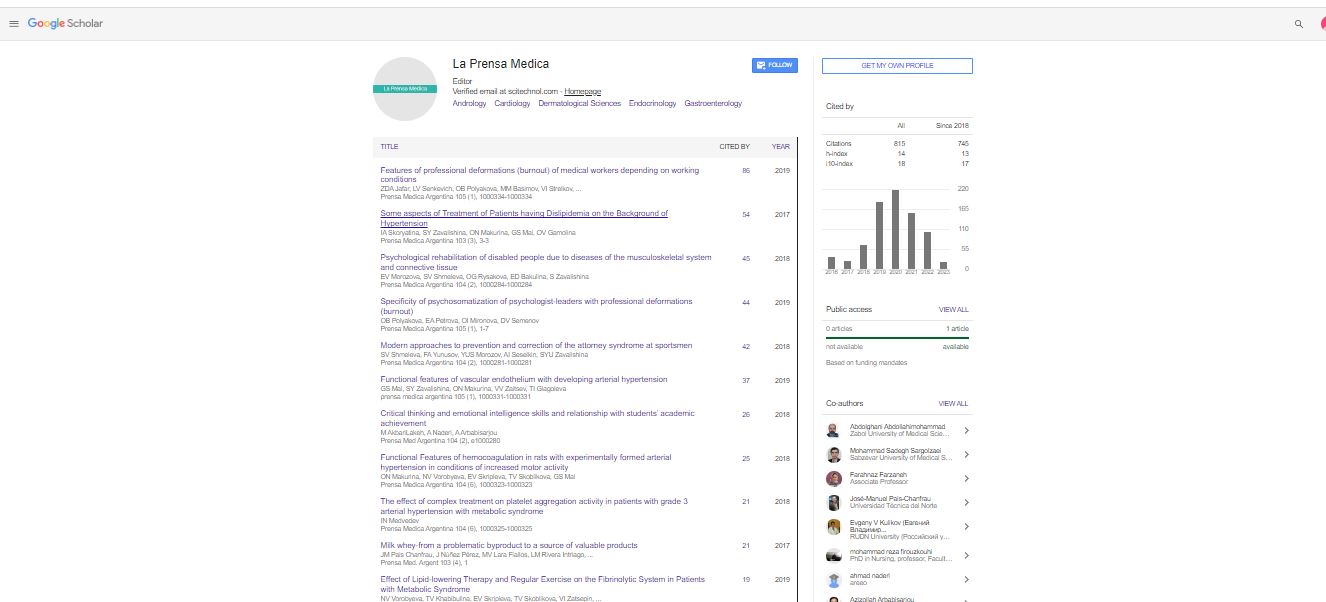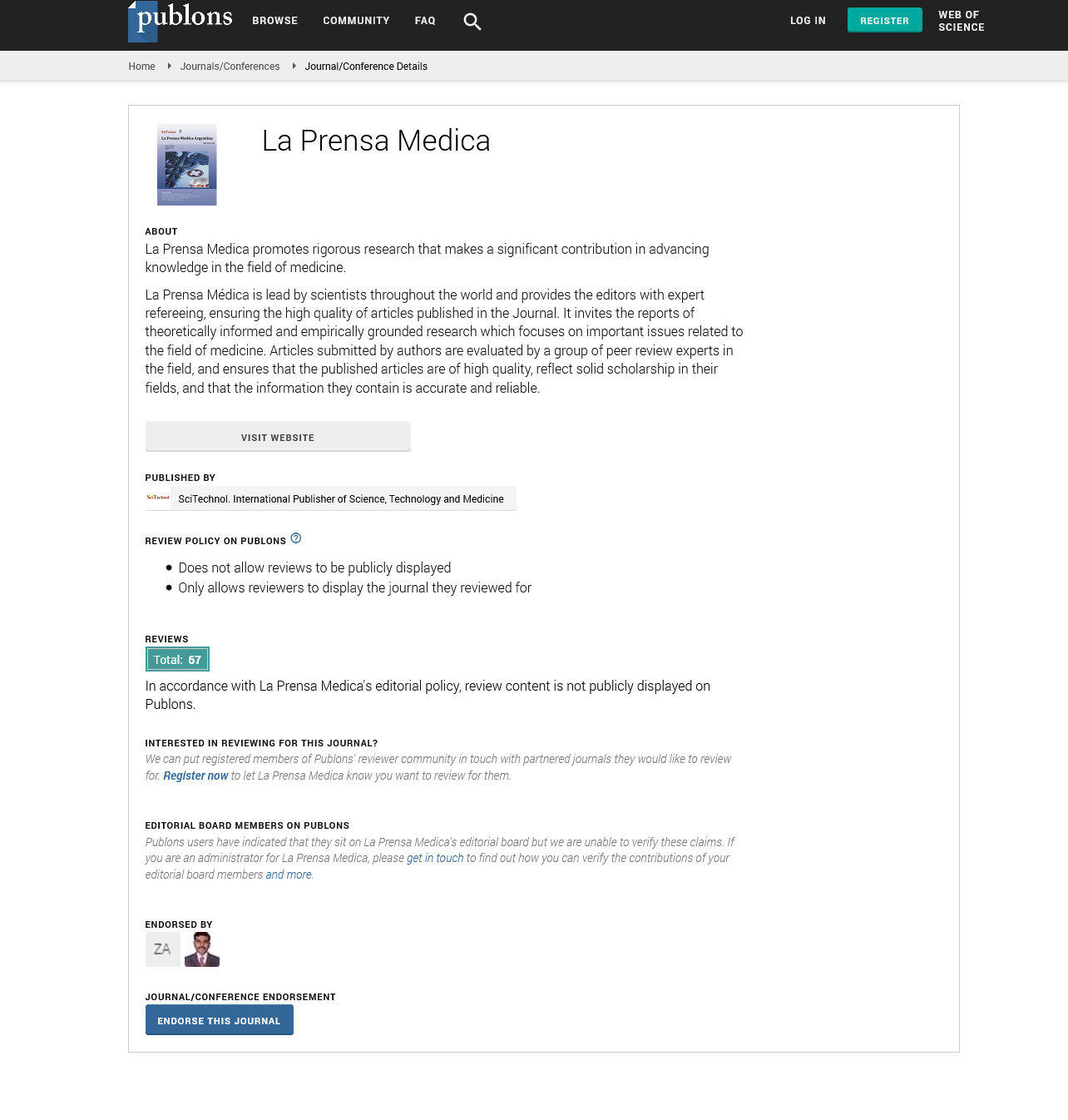Opinion Article, La Prensa Medica Vol: 109 Issue: 3
Postural Orthostatic Tachycardia Syndrome: Complexity and Remedies
Gabriele Mhlanga*
Department of Neuroscience, Karolinska Institutet, Stockholm, Sweden
*Corresponding Author: Gabriele Mhlanga
Department of Neuroscience, Karolinska Institutet, Stockholm, Sweden
E-mail: mhlangag.@neuro.ki.se
Received date: 29 May, 2023, Manuscript No. LPMA-23-107122;
Editor assigned date: 31 May, 2023, PreQC No. LPMA-23-107122(PQ);
Reviewed date: 15 May, 2023, QC No. LPMA-23-107122;
Revised date: 22 June, 2023, Manuscript No. LPMA-23-107122(R);
Published date: 29 June, 2023, DOI: 10.4172/0032-745X.1000172
Citation: Mhlanga G (2023) Postural Orthostatic Tachycardia Syndrome: Complexity and Remedies. La Prensa Medica 109:3.
Abstract
Description
Postural Orthostatic Tachycardia Syndrome (POTS) is a complex disorder characterized by an excessive increase in heart rate upon assuming an upright posture. This study provides a comprehensive review of the pathophysiology, clinical presentation, diagnostic criteria, and management strategies for POTS. The underlying autonomic dysfunction, potential triggers, associated conditions, and treatment options are discussed. The study emphasizes the importance of a multidisciplinary approach and highlights the need for further research to improve our understanding and management of this condition.
About postural orthostatic tachycardia syndrome
Postural Orthostatic Tachycardia Syndrome (POTS) is a disorder that primarily affects young individuals, especially women, and is characterized by a marked increase in heart rate (greater than 30 beats per minute or a rate exceeding 120 bpm) within ten minutes of assuming an upright position. POTS can significantly impact the quality of life and daily functioning of affected individuals. This manuscript aims to provide a comprehensive overview of POTS, including its pathophysiology, clinical presentation, diagnostic criteria, and current management strategies.
Pathophysiology
Postural Orthostatic Tachycardia Syndrome is believed to arise from autonomic dysfunction, involving both sympathetic hyperactivity and parasympathetic impairment. Several underlying mechanisms have been proposed, including abnormal blood volume regulation, vascular hyper-permeability, and altered baroreceptor function. Autoimmune mechanisms and genetic predisposition may also play a role in the development of POTS. However, the exact etiology remains elusive and requires further investigation.
Clinical presentation
POTS is clinically characterized by a wide range of symptoms that are primarily related to orthostatic intolerance. Common symptoms include palpitations, dizziness, lightheadedness, exercise intolerance, fatigue, brain fog, and gastrointestinal disturbances such as nausea and abdominal pain. These symptoms can vary in severity and fluctuate throughout the day, significantly impacting the quality of life of affected individuals.
Diagnostic criteria
The diagnosis of POTS requires the presence of orthostatic symptoms along with an excessive increase in heart rate upon standing. The current diagnostic criteria for POTS, as proposed by the Heart Rhythm Society, include the following:
• A heart rate increment of ≥30 bpm (or reaching ≥120 bpm) within ten minutes of standing, in the absence of orthostatic hypotension.
• The presence of symptoms consistent with orthostatic intolerance.
• The exclusion of other underlying conditions that may cause similar symptoms.
Additional tests, such as tilt table testing and autonomic function testing, may be utilized to confirm the diagnosis and assess autonomic function. It is important to note that the diagnosis of POTS should be made by a healthcare professional experienced in autonomic disorders.
Triggers and associated conditions
POTS symptoms can be triggered or worsened by various factors, which may include prolonged standing, heat exposure, physical exertion, stress, and dehydration. Additionally, POTS may coexist with other conditions such as Ehlers-Danlos Syndrome, Mast Cell Activation Syndrome, small fiber neuropathy, autoimmune disorders, and mitochondrial dysfunction. Identifying and managing these associated conditions is important for comprehensive POTS management and may contribute to symptom improvement.
Non-pharmacological interventions
Adequate fluid and salt intake are essential to expand blood volume and improve orthostatic tolerance. Consuming smaller, more frequent meals and avoiding large carbohydrate-rich meals can help reduce postprandial symptoms. Regular exercise, when well-tailored and gradually introduced, can enhance cardiovascular fitness and improve symptoms. However, exercise regimens should be personalized and guided by healthcare professionals experienced in POTS management.
Engaging in physical maneuvers such as leg exercises, isometric contractions, abdominal compression, and squatting can help mitigate orthostatic symptoms and improve blood circulation. Wearing compression stockings or abdominal binders can improve venous return, reduce pooling in the lower extremities, and alleviate symptoms. POTS can have a significant impact on psychological well-being. Supportive counselling, cognitive-behavioral therapy, and stress management techniques can help individuals cope with the emotional and psychological challenges associated with POTS.
Pharmacological interventions
Beta-adrenergic blockers, such as propranolol or metoprolol, can help regulate heart rate and reduce palpitations. These medications can be particularly beneficial for individuals with POTS who experience significant tachycardia. Fludrocortisone, a mineralocorticoid, can enhance salt and fluid retention, thereby expanding blood volume and potentially improving symptoms. Midodrine is an alpha-1 adrenergic agonist that constricts blood vessels, which can help raise blood pressure and alleviate symptoms. Other Medications: Depending on individual symptoms and needs, other medications such as Selective Serotonin Reuptake Inhibitors (SSRIs) or alpha-2 agonists may be prescribed. These medications can target specific symptom clusters, such as gastrointestinal symptoms or sleep disturbances.
Conclusion
Postural Orthostatic Tachycardia Syndrome is a complex disorder characterized by autonomic dysfunction and orthostatic intolerance. Although progress has been made in understanding and managing POTS, there is still much to learn about its underlying mechanisms and optimal treatment strategies. A multidisciplinary approach involving healthcare professionals from various specialties, including cardiology, neurology, and rehabilitation, is essential to provide comprehensive care for individuals with POTS. Further research is needed to improve our understanding of POTS, develop more targeted therapies, and enhance the overall management and quality of life for individuals affected by this condition.
 Spanish
Spanish  Chinese
Chinese  Russian
Russian  German
German  French
French  Japanese
Japanese  Portuguese
Portuguese  Hindi
Hindi 

